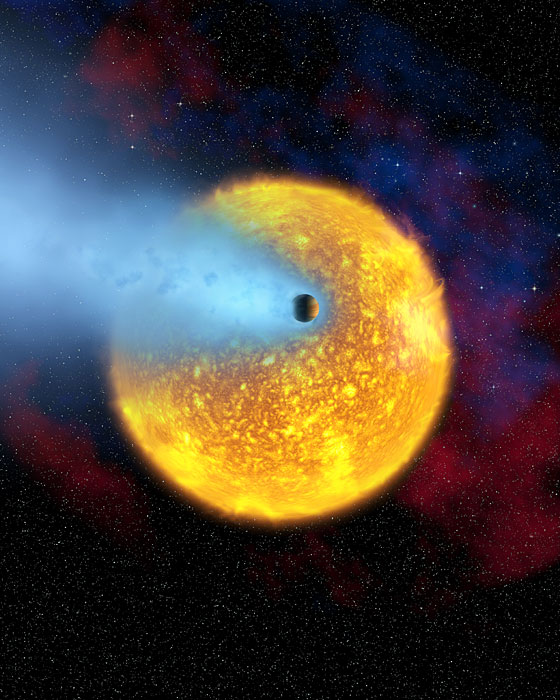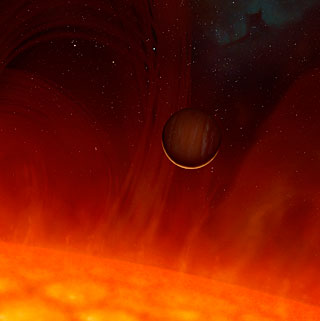C reative
Particle
Higgs
CPH Theory is based on Generalized light velocity from energy into mass.
CPH Theory in Journals
|
Top 10 Exoplanets: Weird Worlds in a Galaxy Not So Far Away [Slide Show]
|
|
A look at some of our extreme planetary neighbors right here in the Milky Way Galaxy August 11, 2008 |
Hoth. Coruscant. Endor. These names will ring familiar to fans of that galaxy far, far away—the setting for the Star Wars movies, including the new animated feature Star Wars: The Clone Wars. Now what about V391 Peg b? GJ 3021 b? WASP-15 b? If you guessed Star Wars droids, you're wrong. They're the names of actual planets found around other stars in our own Milky Way Galaxy. Slowly but surely researchers are learning that our stellar neighborhood is filled withextrasolar planets, better known as exoplanets. Many of them are just as, if not far more, exotic as anything in the Star Wars saga. And someday they may have names that are equally memorable. View the Top Ten Exoplanets Slide Show Scientists have found over 300 exoplanets since 1991, and they hope to find a great deal more. David Bennett, an astrophysicist at the University of Notre Dame and a dedicated planet hunter, says that current estimates peg the number of stars bearing planets at about 30 percent, though he thinks this figure is closer to 50 percent, as researchers believe that current technology is not yet up to the task of spotting certain categories of planets such as small, Earth-size ones. With 100 billion stars populating the Milky Way galaxy, that means some 50 billion planetary systems may await discovery, many of which may hold multiple planets resembling our eight-planet configuration. "We think there are actually more planets out there than stars," says Bennett. Unlike the livable worlds in Star Wars, none of the exoplanets discovered thus far are sufficiently Earth-like in either size or distance from their star to be deemed good candidates for life. The vast majority of known exoplanets are so-called "hot Jupiters" (or "hot Yavins," in Star Wars parlance): large, gaseous bodies orbiting close to their host stars. The apparent preponderance of inhospitable places stems from the limitations of currently available detection methods. Ground-based telescopes gatherindirect evidence of an exoplanet's presence around a star, in the form of regular variations of starlight, and smallish planets like Earth have tiny, hard-to-discern effects on their massive hosts. But NASA and other space organizations have launched or are planning new missions to better identify Earth-like planets. A European satellite called COROT (COnvection ROtation and planetary Transits) has been successfully hunting exoplanets since 2007, and early next year NASA plans to power up the Kepler space telescope. This device will spy on 100,000 stars simultaneously from solar orbit over four years to try and suss out the miniscule signatures of Earth-like planets. For now, we must rely on artist's impressions to get a sense of what all these extrasolar worlds may look like. But getting actual pictures of exoplanets should become possible in the coming years. The New Worlds Observer project, tentatively scheduled to start up late next decade, will use a flower-shaped "starshade" to block out a star's overwhelming, planet-obscuring glare. Scientists then hope to snap direct images of exoplanets and study their atmospheres for telltale signs of life such as oxygen and water vapor. "The New Worlds Observer will allow us to look for evidence of oceans and even continents on exoplanets whose stars are close to Earth," says Webster Cash, the developer of the starshade and an astrophysicist and planetary scientist at the University of Colorado at Boulder.
1. PRIMORDIAL PLANET:Exoplanet PSR B1620-26 b is believed to have formed an incredible 13 billion years ago, less than a billion years after the big bang . Aptly nicknamed Methuselah, this probable gas giant resides in an ancient type of galaxy known as a globular cluster, where it orbits two stellar hosts, a white dwarf star and a pulsar, both remnants of larger stars.
2. EARTH TIMES THREE:The exoplanet MOA-192 b , which orbits a purplish star in this artist's impression, is the smallest discovered so far, measuring about 3.3 Earths in mass
3. IT'S A SMALL(ER) WORLD:Besides being the first exoplanet ever directly observed from Earth as it transited in front of its host star, exoplanet HD 209458 b (aka Osiris) is also shrinking
4. EXOHOTTIE:HD 149026 b ranks as one of the hottest known exoplanets, with a lead-boiling surface temperature of around 3,700 degrees Fahrenheit (2,000 degrees Celsius).
5. NOT TOO HOT OR TOO COLD?:When astronomers spotted Gliese 581 c , it set off a flurry of reports that this exoplanet fell within the so-called "Goldilocks" zone where liquid water can exist on the planet's surface.
6. FREAKISHLY FROZEN WORLD:Scientists think Gliese 436 b (aka GJ 436 b), a Neptune -size exoplanet, is too heavy to be all gas but not heavy enough to be entirely rock. They surmise that in addition to gas and rock, it also contains a kind of pressurized, high-temperature ice that only exists on Earth in laboratories, where it goes by names like "ice VII" and "ice X." The high pressures deep inside the planet may stabilize this alternate solid state of water, similar to the way intense pressures in Earth's crust can squeeze carbon atoms into crystalline diamond .
7. POTPOURRI OF PLANETS:Astronomers discovered a fifth planet around the sunlike star 55 Cancri in 2007, lending a familiar feel to this solar system and making it the most planet-populated one outside our own--so far.
8. SURVIVOR OF APOCALYPSE:V391 Pegasi b distinguishes itself as the only planet known to orbit a star that has passed through its red giant phase . As stars like our sun age, they run low on nuclear fuel in their cores and swell to hundreds of times their original sizes.
9. TYPICAL STAR; EXTRAORDINARY PLANET:The first exoplanet spotted around a typical or " main sequence " star similar to our sun, gaseous 51 Pegasi b completes an orbit around its host star every four days.
10. FIRST EXOWORLD:The first solid evidence for an exoplanet (extrasolar planet) came in 1992 when scientists calculated that two bodies must be orbiting the pulsar PSR 1257.
Source: Scientific American
1 2 3 4 5 6 7 8 9 10 Newest articles
|
|
Sub quantum space and interactions from photon to fermions and bosons |
Interesting articles
Since 1962 I doubted on Newton's laws. I did not accept the infinitive speed and I found un-vivid the laws of gravity and time.
I learned the Einstein's Relativity, thus I found some answers for my questions. But, I had another doubt of Infinitive Mass-Energy. And I wanted to know why light has stable speed?




